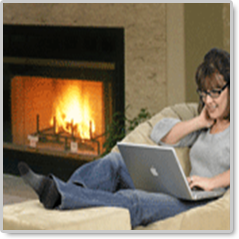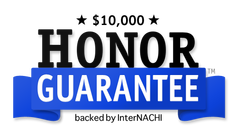 If you have a fireplace (or are considering buying a house which has a fireplace), you probably know how nice an amenity that a fireplace can be. It is a wonderful place to gather the family and guests around, it provides warmth and can add stunning ambiance to your home. But traditional wood-burning fireplaces are not energy efficient, and if not operated properly, they can be very dangerous. This article discusses:
How A Fireplace Works
Despite their appearance of being all warm and cozy, fireplaces tend to be very inefficient for home heating. In fact, the energy efficiencies of fireplaces typically range from only 10% to a minus 10%. The reason the efficiency can be below zero is that the fire draws in heated air from inside the home and vents it up the chimney. In other words, most traditional fireplaces remove more heat from a home than they actually produce! The major components of a fireplace are the firebox, the chimney, the fuel supply (wood) and the air needed for proper combustion. To see a diagram showing the components of your fireplace system (for example the flue liner, ash door, damper, smoke shelf, etc.), see the diagram below. A running fireplace needs constant airflow and fuel. As the fire runs, the hot combustion air goes up the chimney, which rises because the hotter air is less dense than the cooler air outside of your chimney. It’s important to note that all of the air that goes up your chimney has to come from inside your house. For an average fire, this is about 300 cubic feet per minute of air . . . which is the equivalent of three good size bathroom fans all operating at the same time. So where does all of this air for your running fireplace come from? Well, it comes from openings in your home, such as your bathroom and kitchen fan vents, and all of the small openings around your doors, windows, and around pipes penetrations of your walls. And this means on a cold winter day, when your fireplace is running in one room of your house, that it is pulling in 300 cubic feet per minute of ice cold air from outside your house into the other rooms where you have vents, etc . . . and since these are in areas away from your fireplace, it means that your central heating system has to work harder to heat up all of this in-coming cold air. Here are some basic operating tips for your fireplace:
Comments are closed.
|
AuthorDarren Gafiuk Archives
December 2018
Categories
All
|
Open 7 Days a WeekNo Additional Fee for evening or weekend appointments.
Phone: 1-780-499-2739
|
Services |
Member of:Our GuaranteeProud Supporter of: |
© COPYRIGHT 2022. ALL RIGHTS RESERVED.


 RSS Feed
RSS Feed






